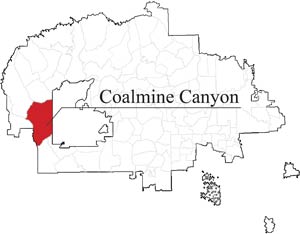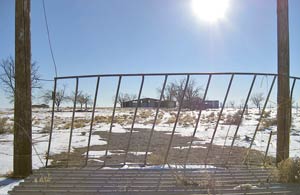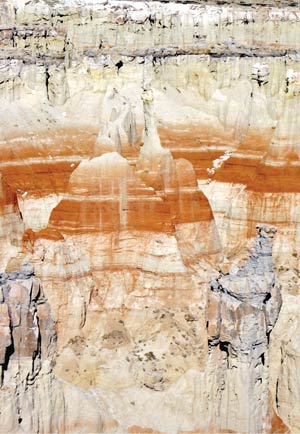The relocated chapter
On the rim of Coalmine Canyon, a community regrows its roots
By Cindy Yurth
Tséyi' Bureau
COALMINE CANYON, Ariz., January 10, 2013

(Editor's note: In an effort to chronicle the beauty and diversity of the Navajo Nation, as well as its issues, the Navajo Times has committed to visiting all 110 chapters in alphabetical order. This is the 17th in the series.)



C oalmine Canyon looks prosperous by Navajo Nation standards.
An imposing chapter house surveys the dramatic landscape, with views of San Francisco Peaks, Navajo Mountain and the western rim of the Grand Canyon.
Two public housing developments, on either side of a wide paved road, appear sturdy and tidy.
But upon closer inspection, this community on the rim of breathtaking Coalmine Canyon is under a pall.
Although the chapter house is a decade old, it looks like people have just moved in. Cardboard boxes lie around, and most of the offices appear to be vacant. When the two chapter employees go to lunch or run an errand, they lock it up.
According to Laura King, everything about Coalmine Canyon Chapter can be summed up in one word: relocation.
The palatial chapter house was built to house not only the chapter administration, but Head Start, the community health representatives and a senior citizens center.
But none of those programs ever moved in, and people have never warmed up to the new building, King said, because "we know why it's there."
The chapter house, like the tidy homes, is a consolation prize from the government, explained the chapter's community services representative, Rena Dodson. You can still see the old chapter compound, vacant and vandalized, four miles to the east along Highway 264, where it stood from 1953 until 1992.
That was the year a U.S. District Judge redrew the western boundary of the Hopi reservation to include much of what was then Coalmine Mesa Chapter. The chapter compound, and the Navajo families living in the area, had to pack up and move four miles to the west.
Compared to some of the other Navajo relocations, it wasn't a big move. But according to King and Dodson, it was pretty devastating for some of the elders.
"I can't really explain it to you unless you went through it," Dodson said. "It's been a challenge. It affects everything in our community."
Even the name of the chapter was changed, from Coalmine Mesa to Coalmine Canyon.
The main loss, explained King, who has become the unofficial spokeswoman for the relocatees of Coalmine, was the livestock.
"People went from having these huge grazing permits to having one-half acre," she said. "That's not enough to graze sheep. Most people had to sell their animals."
And when you take away a Navajo elder's land and animals, King said, "you've taken away their life."
Chapter officials and some community members have tried to create community among the demoralized band of relocatees — some of whom, like King, transferred in from other areas that were absorbed by the Hopi reservation during the Navajo-Hopi land dispute.
But the chapter seems to be paralyzed.
Everything a chapter should be talking about, Dodson said, pokes at a wound that is still very fresh.
"Anything to do with land or livestock is so, so sensitive," she said.
For example, two large herds of feral horses are decimating the vegetation, but the chapter can't muster the will for a roundup.
In addition to the long-running duel with the Hopis, Coalmine has boundary issues with its neighboring Navajo chapters, but nobody is willing to tackle those just yet either.
With the spectacular red-and-white-layered spires of Coalmine Canyon a stone's throw from Highway 264, tourism seems the obvious solution to the chapter's economic woes and unemployment. But after having 90 percent of the chapter boundary redrawn, Coalmine residents are not crazy about the idea of sharing their ever-more-limited space with a horde of camera-toting bilagáanas.
"We like the quiet," Dodson explained. "You can go for an evening walk on the canyon rim almost any time of year, and our kids ride their horses and four-tracks all over the place."
So the majority of the working residents, like King, commute the 16 miles to the hospital, schools and government offices of Tuba City every morning, leaving the young and the old to enjoy the quiet.
A new roster of chapter officials is about to be sworn in, and Dodson is hoping they will be the ones to lead Coalmine out of the spell it has been under.
But King believes the only hope for this beautiful refugee camp is to form a real community.
"Everybody needs to commit to working together," she stated. "That's the only way we're ever going to have anything."
Coalmine Canyon at a Glance
Name — The area was known in Navajo as Leejin Haageed, "Digging out coal," for a coal seam mined in the canyon.
Land area — At 402,357 acres, one of the Navajo Nation's largest chapters
Population — 382, one of the Nation's smallest
Assets — Spectacular scenery along one of the Navajo Nation's busiest arteries gives the area a high potential for tourism
Problems — unemployment, lack of economic development, lingering trauma from relocation during the Navajo-Hopi land dispute, feral horses

